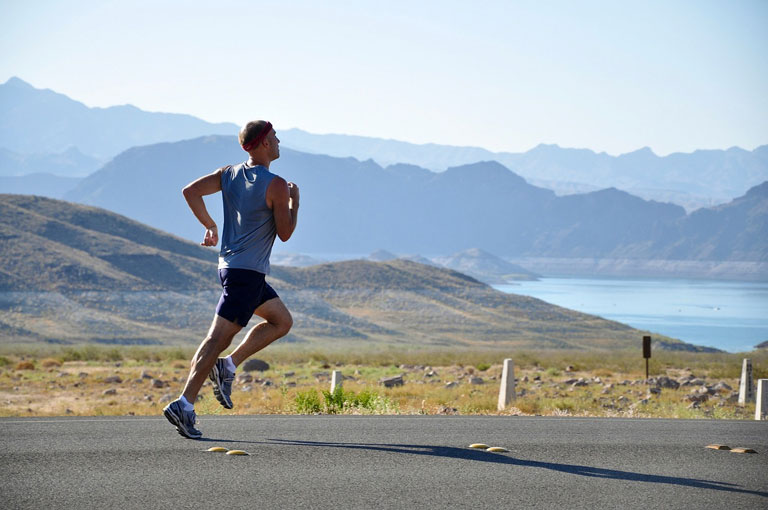
16 Jogging Tips and Guidelines
Learn the many benefits of jogging. You can learn how to jog, get fit safely, and have fun exercising with these jogging tips.
Jogging is as simple as putting one foot in front of the other, right? Right — and wrong. Right because there just isn’t a more basic, down-to-earth, inexpensive way for the average person to achieve fitness than by jogging. Wrong because if it’s so darn easy why do so many people start, and then just up and quit?
Like every other activity, there are certain jogging tips that need to be followed and which — like the guidelines in most other activities — are usually ignored. The results of such ignorance are usually outright injuries and those little (and not so little) aches and pains that can take all the fun out of this simple and otherwise enjoyable hobby-sport.
In an effort to avoid such dead ends while getting more people on the road to fitness, Rory Donaldson and the National Jogging Association have put together a remarkably complete — and inspiring — little book called Guidelines for Successful Jogging.
We’re happy to be able to excerpt a bit of this fine little manual here. It’s just what the title implies — and just what the doctor (or sports podiatrist) ordered!
If you’re reading this hoping for a miraculous conversion to jogging, forget it! No matter what good you’ve been led to expect from exercise you probably won’t “get out there” unless there’s already a small, irrepressible jogger deep inside you struggling to be free: seeking movement, health, sweat, challenge, a fast-beating heart, solitude and play.
(If you’re over 30 and sedentary, check with your doctor before beginning any new exercise programs. If you’re over 35 you should have a maximal-stress-treadmill test in order to safely determine that there are no contra-indications to your jogging at this time. The National Jogging Association may be able to help you locate a facility near you.)
Successful jogging isn’t just a goal, it is also a means of expressing physical potential, grace and beauty. Wise jogging and fitness can develop a base of physical and emotional well-being that will allow you to maximize your freedom of movement throughout the rest of your life. Keep in mind, though, that the way to become a good jogger isn’t by reading jogging tips, but by achieving flexibility and putting in many long, slow, quiet, gentle miles of jogging. “Train, don’t strain,” and slowly — throughout the months and years — your jogging can be wise, safe, gentle, fun and rewarding.
You will need to return, again and again, to the reminder that real accomplishment cannot be gained overnight. It is won over weeks, months and years of regular jogging effort. Your task is not to complete the job of being a jogger, but to begin. Good education and correct practice now can do a great deal to help you find what you’re looking for.
So, begin by putting aside your watch, climbing into some comfortable shoes and loose clothing, and taking a number of regular walks over the next few days. Remember, even too much walking can be overly strenuous for some people, so begin by going out 15 to 60 minutes every other day. As you begin to train and accommodate to this new stress (perhaps far more regular exercise than you’ve had for years), you’ll slowly begin to understand the basic instructions: Take it easy, have fun doing what you’re doing, and don’t hurt yourself.
How to Start Jogging
The natural tendency, now that you are ready to begin, is to demand it all now! Paradoxically, this same self-motivation — so critical to a successful program — can also be your undoing if it leads to stiffness, guilt, fatigue and injury. As well-intentioned as the new jogger usually is, a few highly fevered days of pounding around the block — accompanied by many glances at a watch — will be very discouraging, boring and unpleasant. Why would anyone want to keep this up?
The schedules and recommendations developed in these pages do not need to be strictly followed. There are certain basic principles which must be learned, but you and you alone must learn to make intelligent decisions regarding your training. These are not “hard and fast” rules, but guides that must be bent to fulfill each individual’s needs. Follow an unyielding and inflexible schedule and you’re courting failure.
1. The fact is, jogging takes work, and — especially at first — hard work, but not all that hard. You’ll be surprised if you’re able to develop the discipline necessary to get you through the first eight or 12 weeks. And you are able. Jogging isn’t a sport for supermen, but for all the people, similar to yourself, you notice jogging every day.
2. “Sure, but I’ve tried jogging, and it’s just boring. It’s the boredom that defeats me, I just don’t like it, no matter how much I’d like to be in better shape.” Boredom isn’t the real culprit. The real enemies are those things always associated with boredom: fatigue and anxiety. Fatigue from insisting on pushing too hard and watching the clock, anxiety created from the fear of being defeated by this new undertaking. The only way to beat fatigue is by learning to take it easy. This, in turn, will reduce anxiety.
3. How much time are you going to need? Including a quick shower, at least a full hour four times a week. That is the minimum.
4. Always have enough breath to be able to converse with a jogging companion. Jogging is not racing. If a slow jog is too fast for conversation you should be walking instead.
5. From day one, keep a fitness-training diary. This can be your most important coach, as it can force you to go slowly enough to be able to adapt successfully to new stress. Record your short-term and long-term goals. What are you going to do during the next week? How did last week go?
6. Investing in a good pair of jogging shoes now can save you considerable trouble later, as good shoes have the support and cushioning that’s needed to jog on today’s artificial surfaces. Most people will have no trouble jogging on asphalt or cement as long as they are jogging in a good training shoe and keep the soles of their shoe in like-new condition (sometimes with the help of a hot glue gun, to patch thinning spots).
Tennis and gym shoes are discouraged because they simply aren’t designed to absorb the regular shock of jogging and don’t have the necessary cushioning and support. One shoe will not fit all people. When you try on a new shoe make sure you have plenty of room in the toes, that there is no heel slippage, and no friction on a particular spot. A good jogging shoe should fit well when you buy it and should need no breaking in.
7. Begin developing a “hard-easy” schedule. Plan your training a week in advance so your hard, easy, and rest days are well spaced. Take your rest and easy days. It’s during these periods that your body is allowed to adapt to new stress.
8. The importance of being a “balanced” jogger cannot be overemphasized. The jogger who only jogs, without plenty of additional stretching, is asking for trouble. Regular stretching exercises should become a normal part of your overall training.
9. Are you too old? No one is too old to make significant strides in their physical fitness. However, for the older man or woman, or for a person recovering from an illness or injury, walking may be more advisable than jogging since it is less stressful. Walking is excellent exercise, provided the same gentle approach is used that is so heavily stressed for jogging. An excellent goal to work towards is an average of 45 minutes of brisk walking at least five times a week, though this may take some time to achieve.
10. A rule of thumb: If you’ve been out of shape for 10 years, it’s going to take you at least 10 months to get back into shape and achieve a minimum base-level of fitness. One of the biggest mistakes a jogger can make is to think there are secrets and shortcuts to fitness. There are none! Forget the “quick fix.” Throw away your rubber suits and gimmicks.
Weight lost through sweat loss is irrelevant and deceptive since it’s all liquid and is quickly replaced. What you have to burn off is fat, and that takes time. There are about 3,500 calories in a pound of fat. You burn about 100 calories in a mile of jogging or walking.
11. Before you learn to jog, learn to walk.
- Before you learn to walk, learn to breathe.
- Before you learn to breathe, learn to stand.
Standing: Stand with your weight evenly distributed on the feet, heel and toe in line, legs slightly bent, head well balanced, shoulders relaxed.
Breathing: With your index finger touch the middle of your belly, about an inch or two below your navel. This is your center, where your physical center of gravity is located. Remember this point.
Most of us have learned to breathe shallowly and backwards. We draw our stomachs in when we inhale. This is backwards, for when our stomach is drawn in we cannot draw in full lungs of air. Try it. Touch your center and breathe. Concentrate on pushing your finger out with your belly as you breathe in, and allow your finger to push your belly in as you exhale air out. Breathe through your nose and mouth and fill your lungs from your belly, your center.
Unlock and relax your shoulders in order to allow your lungs to fill deeply to the bottom. If you breathe in this way, your diaphram (the muscular partition between your thorax and abdomen) will move freely and correctly and you will get a full breath.
Belly breathe. Take many deep, slow breaths. Exaggerate. Practice. Open your lungs fully. Try it standing, bending your legs slightly. Relax and breathe from your center, feet about 18 inches apart, neck relaxed, head well balanced.
Walking: Do not walk as though gravity is the enemy. All movement rotates best around your center of gravity. Walking is not all in your legs, it is also in your arms and upper body. Breathe deeply, swing your arms, stay on balance.
Walk stairs two at a time when you’re ready. Rise smoothly from your toes. Then, put on your jogging shoes and sweats and walk. But remember, even walking can be very stressful to the out-of-shape person. Begin slowly.
Jogging: Good jogging starts with the thumbs and ends in the feet. Jog standing nearly straight up, with good posture, weight over your hips. Relax your thumbs, hands, arms, shoulders, neck, jaw, and mouth. Breathe through your nose and mouth. Land with your weight towards your heels. Don’t jog on your toes, that puts all your weight on the small bones at the front of your foot, works against the natural lever-action of your foot, and may lead to injury. Running on the toes is for sprinters.
12. Learn to jog “fartlek,” as the Swedes call it, or speed-play. Jog at varying speeds, perhaps even walking or stopping for a while. Perhaps “turning it on” for just a few moments. Do whatever your spirit, your body, your ability suggest. It is not necessary to jog at every stoplight. The short pause can be very refreshing.
Warm up and walk down. The walk at the end of a jog can be a tremendously satisfying experience.
13. Since you are working yourself in new ways, you must also rest yourself in new ways. The seven hours of sleep you’ve been accustomed to may no longer be sufficient. If you feel sluggish, headachy, irritable, then the chances are excellent you’re not getting enough rest. Try increasing your sleep by an hour a night and allow yourself the rare luxury of an occasional midday nap.
14. The mixing of speed and time (distance) is explosive and dangerous, especially for the novice jogger. When you decide it’s time to increase your training, choose only one variable to push. It is usually best to increase distance (a maximum of 1 mile a week) rather than speed, although improving the quality of your pace may certainly be called for.

15. Good diet. The jogger’s nutritional needs aren’t all that much different from those of the general public, except for perhaps increased fluid and caloric input. The jogger should attempt to get nourishment from fresh, natural sources.
Immediately before, during, and just after running, the runner’s drinking habits should concern him or her more than what’s eaten. A pound of fluid may drain away in as little as 2 miles, and on hot days, the rate may be faster yet. Fluids must be replaced. You needn’t worry about drinking too much fluid, because your kidneys will unload the excess water in a matter of a few hours.
16. A recent National Geographic study found that people who live extremely long lives have several things in common, regardless of where they live. They eat lightly, exercise every day, and their diets contain little or no meat.








Leave a Reply